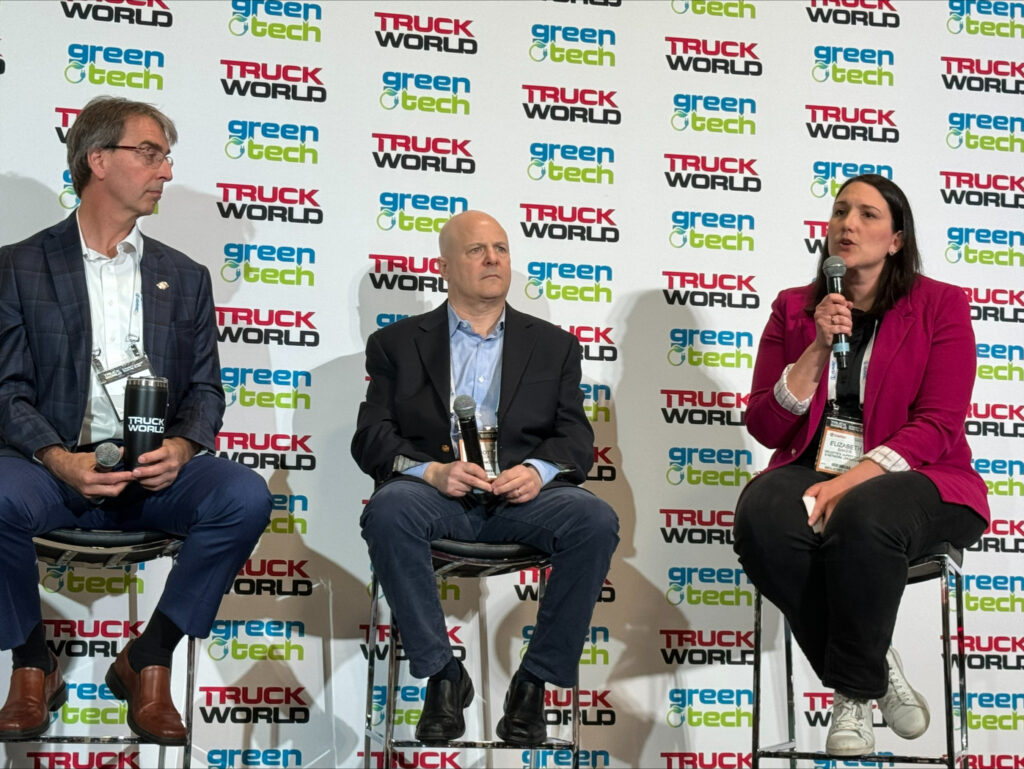Planning, education enable fleet electrification
The integration of battery electric vehicles (BEVs) into fleets demands meticulous planning and education. Research, infrastructure planning, data-driven decision-making and education are essential for identifying suitable vehicles and routes for electrification, said panelists during Truck World’s GreenTech learning session dedicated to the potential of fleet electrification.
Transitioning to BEVs is inevitable, as the industry and society strive toward decarbonization, panelists said.

Kurt Neutgens, Orange EV’s president, warned that sticking with diesel could soon become a costly mistake.
“The financial opportunity, the operational benefits – it’s better in every way,” he said. “If you aren’t doing it now, you’re going to take a hit in three years.”
Scott Beck, vice-president of sales at Battle Motors, agreed, adding that the transition isn’t an all-or-nothing affair.
“If you have a fleet of 100 trucks, electrify 10 of them while you’re upgrading the infrastructure completely. Do the transition gradually.”
When and where does electrification make sense?
However, there is a lot of planning and education that has to be done before integrating BEVs into one’s fleet.
Gabriela Favaron, director of EV Infrastructure at 7Gen, said infrastructure planning – particularly charging infrastructure – is imperative for the successful electrification of a fleet.
This involves understanding the specific requirements of the fleet, such as the daily distance traveled and the types of vehicles being used. This will allow the selection of the appropriate charging infrastructure, including the type of chargers and necessary software.
She said a common mistake made by those new to electrification is they deploy BEVs the same as traditional internal combustion engine (ICE) vehicles. While they are similar in terms of operations, the approach has to be different.
“We didn’t have, for example, gas stations that are in places today, right? In the past, we could just run at a gas station and just fill up there. Now, we’re thinking – depending on your operations – if you will have to build your gas station at your own depot. And that changes completely the dynamic of thinking about the infrastructure, how you design [it] and optimize,” said Favaron, adding that educational initiatives for teams are also essential to ensure readiness and effective implementation of electrification strategies. She emphasized that electrification is a feasible option today, with technology ready to roll out.
What makes the transition feasible?
To determine a starting electrification point, the key lies in decisions based on data, said Elizabeth Baker, partner at Deloitte’s supply chain and network operations. Fleets should assess several factors like understanding what are the vehicles and routes that are electrifiable based on range capacity, available technology and payload.
Next, fleet managers should look at their facilities to evaluate if they are suitable for charging infrastructure. For example, it is best to look for locations with available capacity to accommodate chargers without requiring significant upgrades, which would ease the electrification integration into existing operations.

” And [also], where do you get the best bang for a buck in terms of emissions? So, a vehicle in British Columbia gets higher emissions reduction than, say, a vehicle in Nova Scotia,” Baker said. Based on these assessments and analyses, fleets will be able to identify if some facilities or technologies require upgrades and what locations and vehicles can benefit from electrification presently, not several months or years down the road.
Best applications for BEVs
Considering applications of electrified vehicles is important too.
For example, terminal tractors are a great application for electrification — and it makes ‘perfect sense’ for customers since they can be operated behind the fence. Operating within a confined area such as a terminal or depot allows for a more controlled environment for charging infrastructure deployment, said Orange EV’s Neutgens. Since terminal tractors are already efficient, going electric brings quick gains in cutting emissions and improving efficiency. He added that BEVs work better in cold weather than diesel.
Beck believed that refuse is another good application of electrified trucks, since they are well-suited for shorter routes, typically ranging from 15 to 40 miles, even though they’re capable of much longer distances. This allows them to operate efficiently using level two chargers, reducing the need for high-power level three chargers.
Another advantage of electric refuse trucks is their quieter operation compared to traditional diesel trucks, making them more neighborhood-friendly, especially for early morning municipal collections.
Have your say
This is a moderated forum. Comments will no longer be published unless they are accompanied by a first and last name and a verifiable email address. (Today's Trucking will not publish or share the email address.) Profane language and content deemed to be libelous, racist, or threatening in nature will not be published under any circumstances.